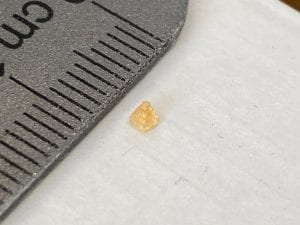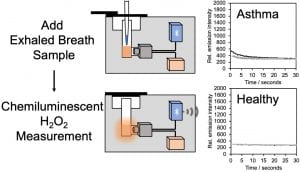Switchable Luminescent Molecules for Bioimaging and Advanced Materials
The Lippert Laboratory specializes in the synthesis and applications of switchable luminescent organic molecules. Specific research techniques span organic synthesis, chemical biology (cell culture and in vivo imaging), analytical chemistry, optics, and microscopy. Projects fall into two general categories, Chemiluminescence Imaging and Molecular Machines.
I. Chemiluminescence Imaging
Funding: NSF CHE 1653474, CHE 2155170, NIH R15GM114792-02, NIH 1R41GM140575-01
The Lippert Laboratory has pioneered the use of chemiluminescent 1,2-dioxetanes for in vivo imaging and live cell measurement. These efforts have contributed to widespread adoption and exuberant research activity in the field. Chemiluminescence is advantageous for imaging by eliminating autofluorescence and reducing light scattering, thereby providing high sensitivity and the ability for deeper tissue imaging. Our work in this area has been aimed at fundamental scaffold design for energy transfer chemiluminescence and in vivo imaging of hypoxia and pH (supported by the NSF) and probe designs for reactive sulfur, oxygen, and nitrogen species (supported by the NIH).
Haris, U.; Kagalwala, H. N.; Kim, Y. J.; Lippert, A. R. “Seeking Illumination: The Path to Chemiluminescent 1,2-Dioxetanes for Quantitative Measurements and In Vivo Imaging.” Acc. Chem. Res. 2021, 54, 2844-2857. doi: 10.1021/acs.accounts.1c00185

The lab has successfully developed the first chemiluminescent ratiometric probes for pH and oxygen. The IrCL series of probes were an exemplary example of chemiluminescence, representing the first example of transition metal-based 1,2-dioxetane chemiluminescence, ratiometric chemiluminescence oxygen sensing, and a rare example of NIR chemiluminescence. The IrCL series consist of linking an iridium complex to a dioxetane via a piperazine linker which was shown to have efficient energy transfer. The dioxetane has an oxygen-insensitive singlet emission, while the iridium centers of IrCL-1, 2, and 3 have triplet emissions. Different ligand sets can be used to systematically red-shift the emission as well as the oxygen sensitivity. These probes were used for quantitative oxygen imaging in vitro and for imaging changes in oxygen levels in living mouse muscle tissue and human tumor xenograft models.
Kagalwala, H. N.; Gerberich, J.; Smith, C. J.; Mason, R. P.; Lippert, A. “Chemiluminescent 1,2-Dioxetane Iridium Complexes for Near-Infrared Oxygen Sensing.” Angew. Chem. Int. Ed. 2022, online publication. doi: 10.1002/anie.202115704

Reactive sulfur, oxygen, and nitrogen species are small reactive molecules that are generated inside of living systems and can be pathological or physiological depending on the circumstances of their generation. The Lippert laboratory has focused on developing new methods for measuring and quantifying these species. The chemiluminescent probe PNCL uses the selective oxidative decarbonylation of isatin by peroxynitrite to achieve high selectivity and sensitivity for detecting peroxynitrite in vitro and in cells. A significant advance was made using the HNO chemiluminescent probe HNOCL-1, where an innovative kinetics-based method for precise real-time quantification of HNO was developed by carefully measuring rate constants and using these to determine HNO concentrations generated in biologically relevant reactions. The future work in the area will be to extend these kinetics-based methods into the realm of chemiluminescence microscopy and in vivo imaging and will be supported by the recently awarded NSF CHE 2155170.
An, W.; Ryan, L. S.; Reeves, A. G.; Bruemmer, K. J.; Mouhaffel, M.; Gerberich, J. L.; Winters, A.; Mason, R. P.; Lippert, A. R. “A Chemiluminescent Probe for HNO Quantification and Real-time Monitoring in Living Cells.” Angew. Chem. Int. Edit. 2019, 58, 1361-1365. doi:10.1002/anie.201811257
Dr. Lippert is the co-founder, Chief Science Officer, and a financial stake holder of the start-up company BioLum Sciences, LLC, which aims to commercialize and clinically translate chemiluminescence technology for clinical disease monitoring. The company has two products. The first product is the BioSense Airway Monitoring Device (AMD), which measures hydrogen peroxide in the exhaled breath condensate for disease monitoring and predicting exacerbation in asthma and chronic obstructive pulmonary disease. The second product is the BioSense VeNO, which measures vascular nitric oxide to monitor cardiovascular disease. The company has raised funding from angel investors, venture capital firms, and pharmaceutical companies including Bayer Pharmaceuticals, which has an equity stake in the company. Additionally, an NSF Phase 1 SBIR has been awarded for the BioSense AMD and an NIH STTR Phase 1 award was granted for the BioSense VeNO.
Quimbar, M. E.; Davis, S. Q.; Al-Farra, S. T.; Hayes, A.; Jovic, V.; Masuda, M.; Lippert, A. R. “Chemiluminescent Measurement of Hydrogen Peroxide in Exhaled Breath Condensate of Healthy and Asthmatic Adults.” Anal. Chem. 2020, 92, 14594-14600. doi: 10.1021/acs.analchem.0c02929
II. Molecular Machines
Funding: ACS PRF ND-6075-ND, Welch N-2038-20200401
Over the past 5-6 years, the Lippert Laboratory was inspired by groundbreaking work in the area of molecular machines and has embarked on a new journey to use switchable luminescence to develop advanced materials and fabrication techniques that apply or can be used to construct molecular machines. This work was initially supported by an ACS PRF New Directions grant (60759-ND1), followed by potentially renewable funding from the Welch Research Foundation(N-2038-20200401). Work in this area began with using fluorescent photoswitches to develop a unique and innovative volumetric 3D display, which has the advantages of incorporating all physiological depth cues, spatial accuracy, and a true structuring of light emission in three dimensions. The display operates by using a spirolactam rhodamine B photoswitch that is transformed into an active fluorescent form using UV light, and then excited with visible light to generate emission only where the two wavelengths intersect. Using digital light processing projectors, 3D images and animations can be generated at the intersection of the two wavelengths. A series of spirolactam rhodamine derivatives were prepared and the kinetics of photoswitching were measured, ultimately providing a proof of principle multi-color 3D display.
Patel, S. K.; Cao, J.; Lippert, A. R. “A Volumetric Digital Light 3D Photoactivatable Dye Display.” Nature Commun. 2017, 15239. doi:10.1039/C7AY01238A [SMU Research] [EurekAlert!] [Phys.Org] [NovusLight] [Optics & Photonics News] [Cosmos Magazine] [Digital Trends]
Having gained experience in optics, and inspired by the vast potential of molecular machines, the group turned its attention towards high resolution microscopic patterning and 3D printing, with the ultimate aim of achieving single molecule resolution photopatterning with visible light as an accessible, safe, and cost-effective method. In this regard, a digital light processing (DLP) fluorescence microscope was constructed and used to achieve microscopic patterning with thiol-ene photoclick chemistry, diazoketone Wolff rearrangement chemistry, and visible light photopolymerization. The chemical micropatterning could be performed on microscopic beads, polymer films, and even in living cells. This setup was strikingly successful and was able to achieve photograph quality resolution microprinting on polymer films, the world’s smallest QR code (according to the Guinness Book of Records), release of molecular dyes with single cell precision, and microscopic 3D polymer prints. The immediate future goal in this area is to advance towards using super-resolution microscopy techniques to achieve single molecule lithography and single molecule 3D printing. As well, this work has spun off several other projects including 3D printed microcapsules for ocular drug delivery (grant pending), a new type of volumetric 3D printing, and the development of new classes of propulsion controlled microrobotics.
Haris, U.; Plank, J. T.; Li, B.; Page, Z. A.; Lippert, A. R. “Visible Light Chemical Micropatterning Using a Digital Light Processing Fluorescence Microscope.” ACS Cent. Sci. 2021, online publication. doi: 10.1021/acscentsci.1c01234





